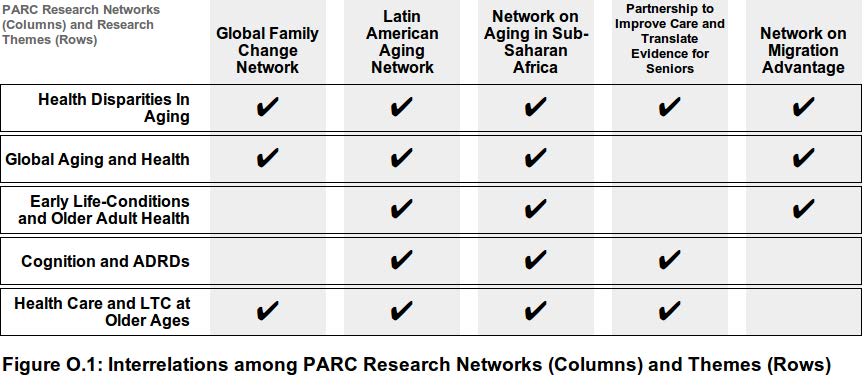Innovation through Cross-cutting Aspects, Research Networks and Interdisciplinary Collaborations. PARC’s Research Themes share cross-cutting interests with PARC’s Research Networks (Figure O.1). Three of the five Research Networks continue activities initiated in the last grant cycle related to aging in Latin America, aging in sub-Saharan Africa (SSA) and the interrelations between migration and aging, and within these networks, research on multiple PARC Themes is pursued domestically and internationally (Figure O.1). The new Global Family Change (GFC) (H-P Kohler) network provides overarching global research on family change and aging, thereby providing fundamental comparative research informing multiple PARC themes about the implications of ongoing transformations of society’s most fundamental building block – the family – for health, wellbeing and social support resources of older persons. The other new research network, PICANTES (Ersek and Burke), is related to PARC signature themes on Cognition and Alzheimer’s Disease and Related Dementias (ADRD) and Health Care and Long-Term Care at Older Ages. The interconnectedness between PARC Networks and Themes, along with network activities that include workshops, extra-mural collaborations, harmonizations of large-scale data collection efforts, and the development of common aging research resources, is a defining characteristic of PARC. The intersections of Themes and Networks (Figure O.1) are a nexus for identifying and facilitating innovative and interdisciplinary aging research opportunities, for instance, by combining biomedical and social science expertise, facilitating access to innovative and/or under-utilized data resources, opening research infrastructures -- such as PICANTES -- to researchers who otherwise would not have access to them, or for expanding cognition and ADRD to international and/or other new population contexts by drawing on ADRD expertise coalesced in PARC's Cognition and ADRD theme. PARC already has a successful track record of stimulating such interdisciplinary collaborations; yet, potentials for such collaborations will be much enhanced through PARC's new cross-school institutional structure and correspondingly evolved membership, the expansion of PARC's themes to ADRD and long-term care, and the creation of several cross-cutting aging research resources by PARC associates (including, for instance, HCAP data from Chile, GFC indicators on social support of older persons, longitudinal aging & cognition data from Malawi, linked Medicare and other administrative data, and other data innovations.
PARC Research Networks:
Global Family Change (GFC) Network: The PARC GFC network builds on a collaboration between Penn, Oxford U, Bocconi U, McGill U, Northwestern U, MPIDR, and UA Barcelona and leverages big data – survey and census data for hundreds of thousands to millions of individuals – to: (i) develop a theory-based and policy-relevant set of comparative indicators of family change at the global level, across multiple dimensions of GFC such as individual behavior, intergenerationally or horizontally “linked lives”, and life-course patterns; (ii) test the leading theories of how and why family systems change with economic and demographic development, including at older ages where these questions have rarely been investigated globally; and (iii) investigate the implications of GFC for the welfare of adults and older individuals by linking diverse patterns of GFC to their demographic, economic, health, and social relations for older persons.
Latin American Network on Aging (LANA): Supporting the ongoing effort by LANA, in collaboration with partners from Chile, Guatemala, Mexico, and Brazil, to: (i) develop harmonized, public-use nationallyrepresentative ELPS (Social Protection Longitudinal Surveys) data from Chile with plans to be integrated in the Gateway to Global Aging Data; (ii) analyze and compare patterns of aging and cognitive decline and their precursors in Mexico, Guatemala and Chile; (iii) analyze and compare the Harmonized Cognitive Assessment Protocol (HCAP) results and their precursors between Chile and Mexico, and (iv) develop new collaborative research activities based on a workshop.
Network on Aging in Sub-Saharan Africa (NASSA): Facilitate further expansion of Penn's long-standing research in SSA that is increasingly expanding into aging-related areas, by drawing on ongoing research projects (e.g., in Malawi, Botswana and Ghana), the PARC/PSC partnership with INED in France, and a to-be-established new partnership with the Heidelberg Institute for Global Health (HIGH). Aims are to: (i) facilitate shared access to comparable aging-related data for SSA, and leverage PARC SSA aging projects and collaborations with NASSA partners to create an innovative and comprehensive evidence basis to address the unique aspects of aging in SSA related to the consequences of high levels of childhood and adult adversities, the implications of aging in the presence of HIV/AIDS, and the interrelations between aging and migration on the national and international scale; (ii) initiate explorations of developing greater integration between LANA and NASSA through developing a new project focusing on cognitive decline among mature adults in LICs.
Partnership to Improve Care and Translate Evidence for Seniors (PICANTES): Building on a practice-based, clinically-focused research network between Penn and nursing homes (NH), PICANTES, to expand the focus of this network to include social science research through integration with PARC. PICANTES’ aims are to: (i) address important economic questions in aging, ranging from cost-effectiveness of interventions, labor economics related to staffing decisions, and technology’s role in managing patient outcomes in this setting that is changing dramatically due to changes in financing models for hospitals, Medicaid, and nursing homes; and (ii) share insights across nursing home and related projects in the US and Chile in collaboration with LANA, and link NH-based care patterns with GFC research on changes in family-based supports for older persons.
Network on Migration Advantage (NeMA): Further develop the collaborative research network with INED and other PARC partners, and develop parallel activities with PARC associates investigating similar concerns in the U.S. This network’s aims are to improve understanding of factors explaining one of the most pervasive results of social epidemiology: that migrants tend to exhibit lower mortality than the non-migrant population of their host countries.
